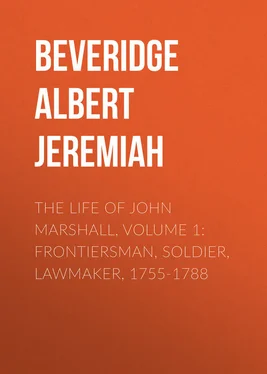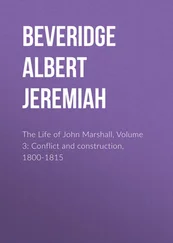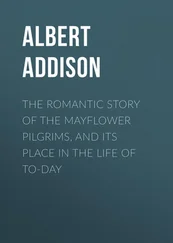Albert Beveridge - The Life of John Marshall, Volume 1 - Frontiersman, soldier, lawmaker, 1755-1788
Здесь есть возможность читать онлайн «Albert Beveridge - The Life of John Marshall, Volume 1 - Frontiersman, soldier, lawmaker, 1755-1788» — ознакомительный отрывок электронной книги совершенно бесплатно, а после прочтения отрывка купить полную версию. В некоторых случаях можно слушать аудио, скачать через торрент в формате fb2 и присутствует краткое содержание. ISBN: , Жанр: foreign_prose, foreign_antique, Биографии и Мемуары, foreign_language, на английском языке. Описание произведения, (предисловие) а так же отзывы посетителей доступны на портале библиотеки ЛибКат.
- Название:The Life of John Marshall, Volume 1: Frontiersman, soldier, lawmaker, 1755-1788
- Автор:
- Жанр:
- Год:неизвестен
- ISBN:http://www.gutenberg.org/ebooks/40388
- Рейтинг книги:5 / 5. Голосов: 1
-
Избранное:Добавить в избранное
- Отзывы:
-
Ваша оценка:
- 100
- 1
- 2
- 3
- 4
- 5
The Life of John Marshall, Volume 1: Frontiersman, soldier, lawmaker, 1755-1788: краткое содержание, описание и аннотация
Предлагаем к чтению аннотацию, описание, краткое содержание или предисловие (зависит от того, что написал сам автор книги «The Life of John Marshall, Volume 1: Frontiersman, soldier, lawmaker, 1755-1788»). Если вы не нашли необходимую информацию о книге — напишите в комментариях, мы постараемся отыскать её.
The Life of John Marshall, Volume 1: Frontiersman, soldier, lawmaker, 1755-1788 — читать онлайн ознакомительный отрывок
Ниже представлен текст книги, разбитый по страницам. Система сохранения места последней прочитанной страницы, позволяет с удобством читать онлайн бесплатно книгу «The Life of John Marshall, Volume 1: Frontiersman, soldier, lawmaker, 1755-1788», без необходимости каждый раз заново искать на чём Вы остановились. Поставьте закладку, и сможете в любой момент перейти на страницу, на которой закончили чтение.
Интервал:
Закладка:
16
Washington to John A. Washington, July 18, 1755; Writings : Ford, i, 175.
17
"The Defeat of Braddock was totally unlooked for, and it excited the most painful surprise." (Lowdermilk, 186.)
18
"After Braddock's defeat, the Colonists jumped to the conclusion that all regulars were useless." (Wood, 40.)
19
See Stanard: Story of Bacon's Rebellion . Bacon's Rebellion deserves the careful study of all who would understand the beginnings of the democratic movement in America. Mrs. Stanard's study is the best brief account of this popular uprising. See also Wertenbaker: V. U. S. , chaps. 5 and 6.
20
"The news [of Braddock's defeat] gave a far more terrible blow to the reputation of the regulars than to the British cause [against the French] itself." (Wood, 61.)
21
"From that time [Braddock's defeat] forward the Colonists had a much less exalted opinion of the valor of the royal troops." (Lowdermilk, 186.) The fact that the colonists themselves had been negligent and incompetent in resisting the French or even the Indians did not weaken their newborn faith in their own prowess and their distrust of British power.
22
Autobiography.
23
Campbell, 494. "It is remarkable," says Campbell, "that as late as the year 1756, when the colony was a century and a half old, the Blue Ridge of mountains was virtually the western boundary of Virginia." And see Marshall, i, 15; also, New York Review (1838), iii, 330. For frontier settlements, see the admirable map prepared by Marion F. Lansing and reproduced in Channing, ii.
24
Humphrey Marshall, i, 344-45. Also Binney, in Dillon, iii, 283.
25
See infra , chap. II.
26
Humphrey Marshall, i, 344-45.
27
He was one of a company of militia cavalry the following year, (Journal, H.B. (1756), 378); and he was commissioned as ensign Aug. 27, 1761. (Crozier: Virginia Colonial Militia , 96.) And see infra , chaps, III and IV.
28
Paxton, 20.
29
A copy of a letter (MS.) to Thomas Marshall from his sister Elizabeth Marshall Martin, dated June 15, 1755, referring to the Braddock expedition, shows that he was at home at this time. Furthermore, a man of the quality of Thomas Marshall would not have left his young wife alone in their backwoods cabin at a time so near the birth of their first child, when there was an overabundance of men eager to accompany Braddock.
30
Washington MSS., Lib. Cong.
31
Simon Kenton, the Indian fighter, was born in the same county in the same year as John Marshall. (M'Clung: Sketches of Western Adventure , 93.)
32
Neither the siege of Louisburg nor the capture of Quebec took such hold on the public imagination as the British disaster on the Monongahela. Also, the colonists felt, though unjustly, that they were entitled to as much credit for the two former events as the British.
33
The idea of unity had already germinated. The year before, Franklin offered his plan of concerted colonial action to the Albany conference. ( Writings : Smyth, i, 387.)
34
Wood, 38-42.
35
For these genealogies see Slaughter: Bristol Parish , 212; Lee: Lee of Virginia , 406 et seq. ; Randall, i, 6-9; Tucker, i, 26. See Meade, i, footnote to 138-39, for other descendants of William Randolph and Mary Isham.
36
Va. Mag. Hist. and Biog. , iii, 261; xviii, 86-87.
37
The curious sameness in the ancestry of Marshall and Jefferson is found also in the surroundings of their birth. Both were born in log cabins in the backwoods. Peter Jefferson, father of Thomas, "was the third or fourth white settler within the space of several miles" of his cabin home, which he built "in a small clearing in the dense and primeval forest." (Randall, i, 11.) Here Jefferson was born, April 2, 1743, a little more than twelve years before John Marshall came into the world, under like conditions and from similar parents.
Peter Jefferson was, however, remotely connected by descent, on his mother's side, with men who had been burgesses. His maternal grandfather, Peter Field, was a burgess, and his maternal great-grandfather, Henry Soane, was Speaker of the House of Burgesses. But both Peter Jefferson and Thomas Marshall were "of the people" as distinguished from the gentry.
38
Morse, 3; and Story, in Dillon, iii, 330.
39
Randall, i, 7. Peter Jefferson "purchased" four hundred acres of land from his "bosom friend," William Randolph, the consideration as set forth in the deed being, "Henry Weatherbourne's biggest bowl of arrack punch"! ( Ib. )
40
Peter Jefferson was County Lieutenant of Albemarle. ( Va. Mag, Hist. and Biog. , xxiii, 173-75.) Thomas Marshall was Sheriff of Fauquier.
41
Randall, i, 12-13; and see infra , chap. II.
42
Tucker, i, 26.
43
Records of Westmoreland County, Deeds and Wills, viii, I, 276.
44
Ib. Seventy years later La Rochefoucauld found land adjoining Norfolk heavily covered with valuable timber, close to the water and convenient for shipment, worth only from six to seven dollars an acre. (La Rochefoucauld, iii, 25.) Virginia sold excellent public land for two cents an acre three quarters of a century after this deed to John Marshall "of the forest." (Ambler, 44; and see Turner, Wis. Hist. Soc, 1908, 201.) This same land which William Marshall deeded to John Marshall nearly two hundred years ago is now valued at only from ten to twenty dollars an acre. (Letter of Albert Stuart, Deputy Clerk of Westmoreland County, to author, Aug. 26, 1913.) In 1730 it was probably worth one dollar per acre.
45
A term generally used by the richer people in referring to those of poorer condition who lived in the woods, especially those whose abodes were some distance from the river. (Statement of W. G. Stanard, Secretary of the Virginia Historical Society and Dr. H. J. Eckenrode of Richmond College, and formerly Archivist of the Virginia State Library.) There were, however, Virginia estates called "The Forest." For example, Jefferson's father-in-law, John Wayles, a wealthy man, lived in "The Forest."
46
Will of John Marshall "of the forest," made April 1, 1752, probated May 26, 1752, and recorded June 22, 1752; Records of Westmoreland County, Deeds and Wills, xi, 419 et seq. (Appendix II.)
47
Ib. , 421.
48
Autobiography . Marshall gives the ancestry of his wife more fully and specifically. See infra , chap. V.
49
Will of Thomas Marshall, "carpenter," probated May 31, 1704; Records of Westmoreland County, Deeds and Wills, iii, 232 et seq. (Appendix I.)
50
Most curiously, precisely this is true of Thomas Jefferson's paternal ancestry.
51
There is a family tradition that the first of this particular Marshall family in America was a Royalist Irish captain who fought under Charles I and came to America when Cromwell prevailed. This may or may not be true. Certainly no proof of it has been discovered. The late Wilson Miles Cary, whose authority is unquestioned in genealogical problems upon which he passed judgment, decided that "the Marshall family begins absolutely with Thomas Marshall, 'Carpenter.'" (The Cary Papers, MSS., Va. Hist. Soc. The Virginia Magazine of History and Biography is soon to publish these valuable genealogical papers.)
Читать дальшеИнтервал:
Закладка:
Похожие книги на «The Life of John Marshall, Volume 1: Frontiersman, soldier, lawmaker, 1755-1788»
Представляем Вашему вниманию похожие книги на «The Life of John Marshall, Volume 1: Frontiersman, soldier, lawmaker, 1755-1788» списком для выбора. Мы отобрали схожую по названию и смыслу литературу в надежде предоставить читателям больше вариантов отыскать новые, интересные, ещё непрочитанные произведения.
Обсуждение, отзывы о книге «The Life of John Marshall, Volume 1: Frontiersman, soldier, lawmaker, 1755-1788» и просто собственные мнения читателей. Оставьте ваши комментарии, напишите, что Вы думаете о произведении, его смысле или главных героях. Укажите что конкретно понравилось, а что нет, и почему Вы так считаете.












